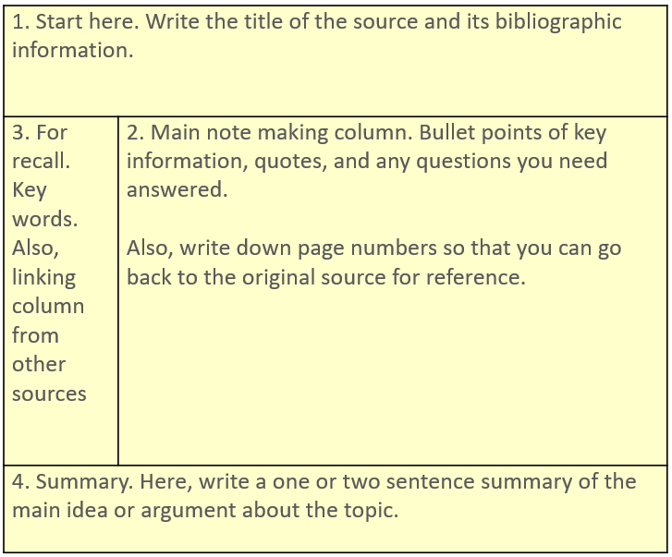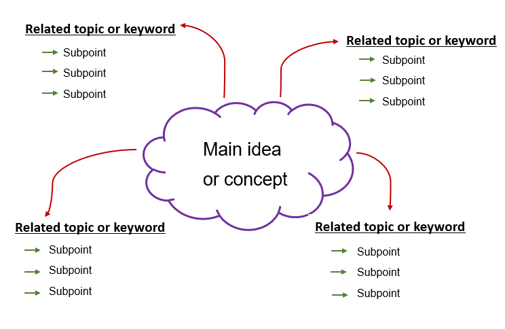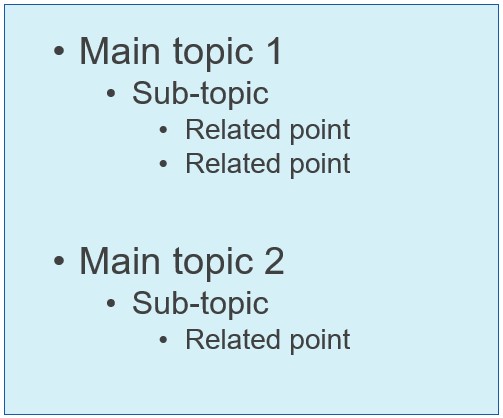Reading and Note taking
Note-taking is an integral part of successful study and learning, helping you to organise and transform the content you hear or read into your own understanding. Note-taking helps you move confidently between the reading and writing stages, enabling you to capture key ideas in your own words and establish links between different sources.
In brief, in order to take good notes, you should:
- Ensure you have effective note-taking strategies to help you transform information from sources into usable knowledge for your assignments.
- Recording notes in your own words using techniques like Cornell note-taking, mind-mapping or outlining which will help with the process of paraphrasing and summarising, helping you avoid inadvertent plagiarism.
- Use your notes to help you identify links between readings so you can synthesise information and plan the structure of your assignment.
Be sure to keep accurate records of the things you read for referencing, including the details of the author, date, title and source (where you can find the work). There are a few different ways you can do this. One of them is by using a reference management tool like EndNote.
Strategies
Good notes are useful notes. They should be a stepping stone between the information you receive – from your lectures and readings – to enabling you to demonstrate your knowledge on a topic in an assignment.
So, how do you take good, useful notes? That all depends on you and your learning style. There are many ways of taking notes – we’re going to expand on a couple; however, if you don’t see anything that works for you, check out #studyspo for some additional inspiration and approaches.
All note-taking styles do have a few things in common. When recording your notes:
- Keep your assignment question and thesis statement in mind as you read and take notes. It will help guide you to the most useful information in the source.
- Record useful information in your own words, rather than copying from the source word for word. This is important in ensuring that you understand the content, as well as helping you paraphrase and avoid accidental plagiarism. You won’t be submitting your notes - no one else will see them - so they don’t need to be written in perfect, academic English.
- Think about other sources that you have read, and the links or disagreements between them. This will help you to synthesise in your writing.
- Always record the details of the source for your reference list (and so that you can find it again!).
Watch this short video for 10 tips!
Let’s look at a couple of note-taking strategies - Cornell note taking, mind mapping, and the outlining method - in more depth:
Cornell note-taking
The Cornell note-taking method focuses on an individual source, and provides structure to the note-taking process. It gives you the opportunity to record key information from the source, pose questions to yourself and write a summary in your own words.
Method:
- On a piece of paper, draw a line horizontally two-thirds of the way down the page.
- In the top section, draw a vertical line, dividing the page in two.
- Label the top-left section ‘cue’, the top-right section, ‘notes’ and the bottom section, ‘summary.
- Complete the notes section first with facts, definitions, important details and anything noteworthy.
- Next, complete the summary section, capturing the main ideas of the article. You should do this without referring to the article itself as it will help ensure that the summary is done in your own words, but you can refer back to your notes.
- Lastly, complete the cue section by recording any questions you have after reading. Is there anything you didn’t understand? Obvious connections or contrasts to other readings? Gaps in knowledge or understanding you need to fill?
Example:

Mind-mapping
Mind mapping is a visual note-taking style that emphasises the connections between ideas. It can be used to capture notes from a single source, or to link ideas from a number of different sources together. Mind mapping is an effective strategy for assignment planning, allowing you to establish the main concepts that will form your paragraphs and the readings and connections that support them.
Method (if capturing notes from a single article):
- Write the main idea from an article in the centre of a blank piece of paper. Draw a circle around it.
- Identify the main concepts and write them down too, with a line linking them back to the main idea.
- Under each concept, write down the important facts, definitions, anything note-worthy that relates to that concept
- Identify the links between information by drawing lines to connect them.
Method (if summarising multiple sources)
- Write your assignment question in the centre of the page and draw a circle around it.
- Around this circle, write the main ideas or concepts you would like to cover in your assignment. Draw a circle around them too.
- Under those ideas, write down the important facts, supporting sources, and any particular statistics or research you would like to include.
Example:

The outline method
The outline method is a structured note-taking style, where information from a source is organised into main ideas and supporting information using indentations. In practice, your notes will look something like this:
- This is a main idea/topic
- This is a sub-topic or an idea that supports or illustrates the main topic
- This is a supporting fact, piece of evidence or thought related to the main idea.
- This is a sub-topic or an idea that supports or illustrates the main topic
Method:
- Read through the source in full to help you identify the main points before you start the note-taking approach.
- Record your first main idea/point as a bullet point.
- Elaborate on the main ideas underneath, with a new bullet point for each new idea. Record these new points further from the left-margin, so at a glance, you can identify how main ideas you’re capturing. Try to keep your notes brief, aiming for one sentence per point.
- If required, support your second-level notes with more information with more information, always moving your new level further from the left-margin.
Example:

Synthesising
Note-taking strategies are useful for identifying information from a source that is useful for your assignment. They allow you to isolate the most relevant information to your question and begin the translation process from the author’s words to your own. Note-taking strategies are also great for looking at the bigger picture, combining the things you’ve read, with the information presented in your lectures, along with any ideas and opinions you have. This process of putting things together is called synthesising; it allows you to create connections and form a more complete picture of the topic.
When you synthesise you identify connections in the research, points where there are common findings or ideas. You will also be able to see where there are different or contrasting ideas. Establishing these connections is a key step as you move towards writing your assignment.
Planning your assignment
You can now use your chosen note taking strategy, or strategies, to begin synthesising the information that you have found, finding main concepts that will become paragraphs or sections in your assignment. Synthesising is a key element of integrating your sources, as it allows you to begin to plan what information you will need to paraphrase or summarise in your assignment. More information can be found in the Writing guide.
As you start to see how your sources are connected you can begin thinking about how they will go together in your assignment. You can now start to think about the structure that will hold your assignment together and creating an assignment outline using your notes.
Your notes may help you to start considering:
- How many paragraphs your assignment might contain;
- The number of sections you may be required to have; and
- Any relevant quotes or statistics you may like to include.
As you piece together your information and begin to you make your plan, you could also start to note down the primary elements of your assignment, such as a thesis statement for your introduction and topic sentences for your paragraphs.